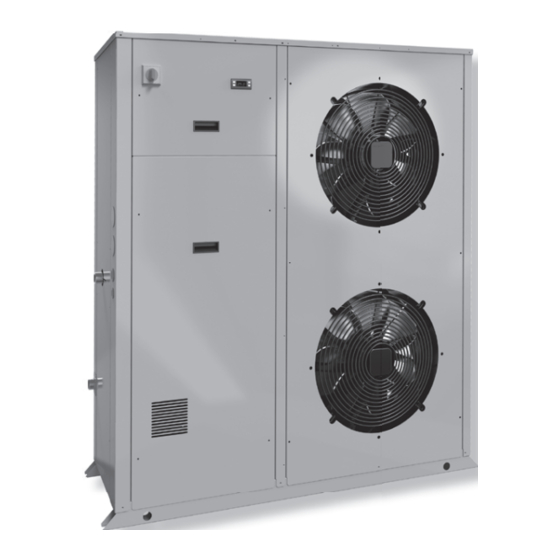Advertisement
Quick Links
Installation and maintenance manual
Manuel d'installation et de maintenance
Installations- und Wartungshandbuch
Manuale di installazione e di manutenzione
Manual de instalación y de mantenimiento
SYSCROLL 20-30 Air EVO HP
English
Air Cooled Water Chillers and Heat Pumps
7
Refroidisseurs de liquide à condensation par air et pompes à chaleur air-eau
33 kW
Luftgekühlte Flüssigkeitskühler und Wärmepumpen
Refrigeratori d'Acqua e Pompe di Calore Raffreddati ad Aria
7
Enfriadores de Agua y Bomba de Calor Condensadas con Aire
35 kW
Part number / Code / Code / Codice / Código /
Supersedes / Annule et remplace / Annulliert und ersetzt / Annulla e sostituisce / Anula y
sustituye /
Notified Body / Organisme Notifié / Benannte Zertifizierungsstelle / Organismo
Notificato / Organismo Notificado /
Français
Deutsch
None / Aucun / Nicht / Nulla / Ninguno /
:
Italiano
364321
:
N°. 1115
ISO 9001:2008 certified management system
Español
Advertisement

Summarization of Contents
1 - FOREWORD
1.1 Introduction
Provides an overview of the unit's capabilities and intended use.
1.2 Warranty
Details conditions for warranty validity and what voids it.
1.3 Emergency stop / Normal stop
Explains how to perform emergency and normal stops.
1.4 An introduction to the manual
Explains the manual's structure and conventions used.
2 - SAFETY
2.1 Foreword
States installation conformity with directives and general safety principles.
2.2 Definitions
Defines key roles like OWNER, INSTALLER, OPERATOR, ENGINEER.
2.3 Access to the unit
Specifies requirements for accessing the unit area and personnel.
2.4 General precautions
Lists general precautions for operators and installers.
2.5 Precautions against residual risks
Details risks related to control systems, mechanical, and electrical components.
2.6 Precautions during maintenance operations
Outlines safety measures before and during maintenance.
2.7 Safety labels
Illustrates and explains various safety labels and warnings.
2.8 Safety regulations
Details safety data for R410A refrigerant and POE oil.
3 - TRANSPORT, HANDLING AND STORAGE
3.1 Inspection
Instructions for inspecting the unit upon receipt for damage.
3.2 Handling
Procedures and precautions for lifting and moving the unit.
3.3 Anchoring
Guidance on securing the unit to its foundation.
3.4 Storage
Precautions for storing the unit before installation.
4 - INSTALLATION
4.1 Installation Site
Criteria for selecting a suitable installation location for the unit.
4.2 External Water Circuit
Requirements and components for the external water circuit.
4.3 Water connections
Details on connecting water lines to the unit's inlets and outlets.
4.4 Defrost water drainage
Instructions for managing defrost water drainage.
4.5 Water buffer tank
Information on the water buffer tank features and installation.
4.6 Power supply
Guidelines for connecting the unit to the electrical power supply.
4.7 Electrical connections
Specific instructions for making electrical connections to the unit.
5 - START-UP
5.1 Preliminary check
Lists essential checks to perform before starting the unit.
5.2 Start-up
Outlines the step-by-step procedure for starting the unit.
5.3 Checking the operation
Key parameters to check after the unit has started.
5.4 Delivery to the customer
Instructions for training the user upon delivery.
6 - CONTROL
6.1 & 6.2 Control System and Keypad
Overview of the unit's control system and keypad functions.
6.3 & 6.4 Alarms and Menus
Explains alarm indicators and navigation through control menus.
6.6 Parameters List
Lists and defines all configurable parameters for the unit's operation.
6.7 Alarm List
Provides a comprehensive list of all possible alarms and their origins.
7 - PRODUCT DESCRIPTION
7.1 General Information
Describes the unit's general features, capabilities, and intended use.
7.2 Accessories
Lists and describes optional and standard accessories for the unit.
7.3 Refrigerant flow diagram
Illustrates the path of the refrigerant through the unit's circuits.
8 - TECHNICAL DATA
8.1 Hydraulic Features
Provides graphs for pump pressure and circuit pressure drops.
8.2 Physical data
Lists physical specifications like dimensions, weight, and component types.
8.3 Electrical data
Details electrical specifications such as power supply and current ratings.
8.4 Dimensional Drawings
Presents detailed drawings of the unit's dimensions and connections.
8.5 Space Requirements
Specifies the minimum clearance required around the unit.
9 - MAINTENANCE
9.1 & 9.2 Maintenance Requirements and Schedule
Outlines general maintenance principles and a planned maintenance schedule.
9.3 Refrigerant Charge and Compressor
Procedures for refrigerant charging and compressor maintenance.
9.5, 9.6, 9.7 Condenser, Fans, and Filter
Maintenance tasks for condenser, fans, and dehydrating filter.
9.8, 9.9, 9.10 Sight Glass, Expansion Valve, and Evaporator
Checks and maintenance for sight glass, expansion valve, and evaporator.
10 - TROUBLESHOOTING
Troubleshooting Table
Lists operational anomalies, their causes, and corrective actions.
11 - SPARE PARTS
11.1 Spare part list
Lists recommended spare parts for the first two years of operation.
11.2 Oil for compressors
Specifies the type of lubricating oil used for compressors.
11.3 Wiring diagrams
Location of wiring diagrams and how to request them.
12 - DISMANTLING, DEMOLITION AND SCRAPPING
12.1 Generalities
General procedures and safety precautions for dismantling and disposal.

















Need help?
Do you have a question about the Syscroll Air EVO HP 30 and is the answer not in the manual?
Questions and answers